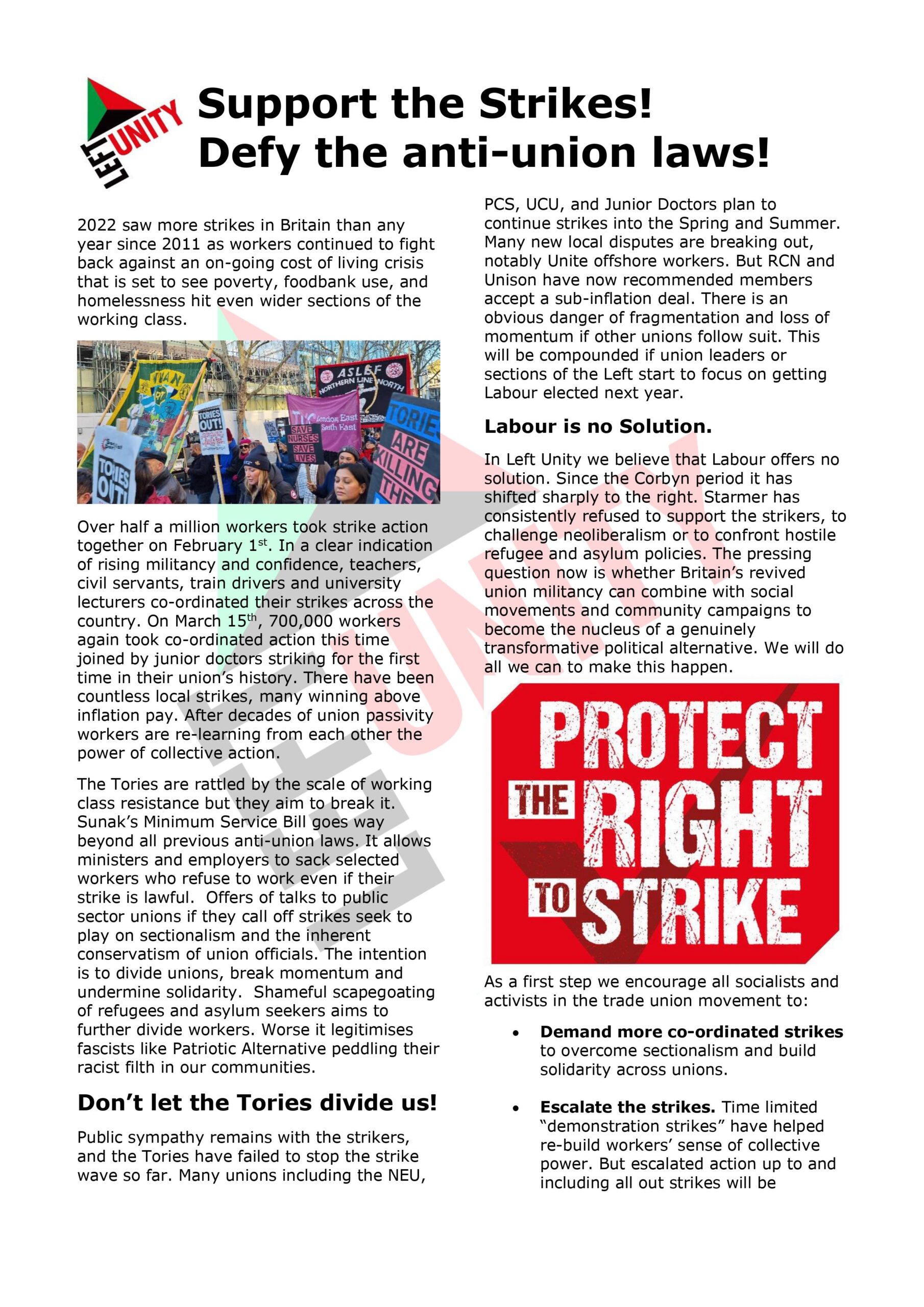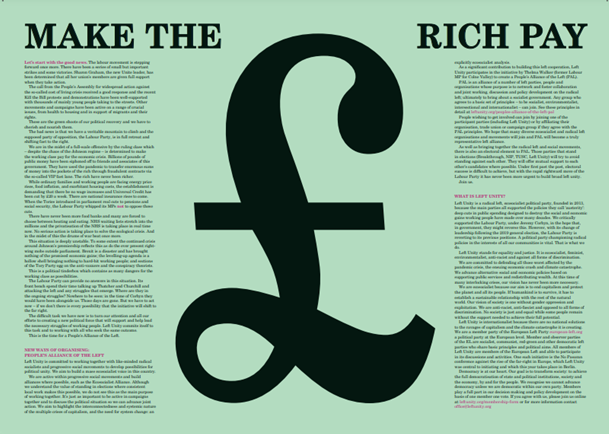The cash hoard of Western companies
 Supporters of ‘austerity’ would have a very strong argument if there really were no money left, says economist Michael Burke. In that case, opponents of current policy would be left arguing only for a fairer implementation of those policies, or that perhaps they could be implemented more slowly.
Supporters of ‘austerity’ would have a very strong argument if there really were no money left, says economist Michael Burke. In that case, opponents of current policy would be left arguing only for a fairer implementation of those policies, or that perhaps they could be implemented more slowly.
This negative trend of declining proportion of profits directed towards investment reached crisis proportions in 2008 and is the cause of the slump. As a consequence of the sharp fall in this investment ratio there has been a sharp rise in the both the capital distributed to shareholders and in the growth of a cash hoard held by Non-Financial Corporations (NFCs). This cash hoard is a barrier to recovery, releasing it could be the mechanism for resolving the crisis.
The chart below shows the level of surplus generated by US firms (Gross Operating Surplus) and the level of investment (Gross Fixed Capital Formation) for the whole economy. Since the former are only presented in nominal terms, both variables are presented here in the comparable way.
The nominal increase in profits has not been matched by an increase in nominal investment. In 1971 the investment ratio (GFCF/GoS) was 62%. It peaked in 1979 at 69% but even by 2000 it was still over 61%.
It declined steadily to 56% in 2008. But in 2012 it had declined to just 46%.
In a truly dynamic market economy there is nothing to prevent the investment ratio from exceeding 100% as firms utilise resources greater than their own (borrowing) in order to invest and achieve greater returns.
Therefore even an investment ratio of 69% is sign of a less than vigorous market economy.
However the subsequent decline in the investment ratio to 46% is a sign of enfeeblement. If US firms investment ratio were simply to return to its level of 1979 the nominal increase in investment compared to 2012 levels would be over US$1.5 trillion, approaching 10% of GDP. This would be enough to resolve the current crisis, although it would not prevent the re-emergence of later crises.
Distribution of profits
The uninvested portion of firms’ surplus essentially has only two destinations, either as a a return to the holders of capital (both bondholders and shareholders), or is hoarded in the form of financial assets. In the case of the US and other leading capitalist economies both phenomena have been observed. The nominal returns to capital have risen (even while the investment ratio has fallen) and financial assets including cash balances have also risen. One estimate of the former shows the dividend payout to shareholders doubling in the 8 years to 2012, an increase of US$320bn per annum.
The growth of cash balances is shown in the following data from the Federal Reserve. They are the changes in key balance sheet aggregates for US non-financial corporations from 2008 to Q2 2013.
Change in Balance Sheet Components, US NFCs, 2008 to Q2 2013, US$bn.
| 2008 | Q2 2012 | Change | |
| Total assets | 29,881 | 33,662 | 3,781 |
| Total net assets (deducting liabilities) | 16,656 | 19,470 | 2,814 |
| Non-financial assets | 16,945 | 17,686 | 741 |
| Financial assets | 12,937 | 15,975 | 3,038 |
| -checkable deposits | 14 | 386 | 372 |
| -time deposits | 382 | 597 | 215 |
| -non-financial item: Business equipment |
3,896 | 4,191 | 295 |
Source: Federal Reserve
Total assets of US NFCs have risen by nearly US$4trillion over the period which is equivalent to approximately 25% of US GDP. The increase in net assets of US$2.8bn (after accounting for the rise in liabilities over the same period) is more than accounted for by a rise in financial assets of over US$3 trillion.
By comparison the rise in the current cost value of business equipment has been less than one-tenth that (and is accounted for by inflation).
Within the rise of financial assets, cash or near-cash instruments have contributed a rise of nearly $600bn (the biggest single contributor in the accounts is ‘miscellaneous financial assets’).
Generalised phenomena
The same is true in other capitalist economies. In 1995 the investment ratio in the Euro Area was 51.7% and by 2008 it was 53.2%. It fell to 47.1% in 2012. In Britain the investment ratio peaked at 76% in 1975 but by 2008 had fallen to 53%. In 2012 it was just 42.9% (OECD data).
The cash hoards are no less striking. The total deposits of NFCs in the Euro Area rose to €1,763bn in July 2013 of which €1,148bn is overnight deposits. This is a rise of €336bn since January 2008, nearly all of which is in overnight deposits, €306bn. In Britain the rise in NFCs bank deposits has been from £76bn at end 2008 to £419bn by July 2013.
In reality, this extraordinary accumulation of cash by NFCs began well before the immediate depression in 2008, along with the slump in investment. Both of these merit further elaboration elsewhere.
Conclusion
The profitability (profit rate) of US firms and firms in other Western economies has fallen, and even the absolute mass of profits fell for a period in the recession. While the former has not recovered, the latter has. But this has not led to a corresponding rise in investment and the investment ratio has fallen sharply.
The destination of of these uninvested profits is twofold. Owners of capital are in receipt of record payouts. And the financial assets of NFCs have risen dramatically, often primarily cash as firms are unwilling to risk any type of investment.
This hoarded store of capital is both the main impediment to recovery and the potential source of resolving the current phase of the crisis.
3 comments
3 responses to “The cash hoard of Western companies”
Left Unity is active in movements and campaigns across the left, working to create an alternative to the main political parties.
About Left Unity
Read our manifesto
Left Unity is a member of the European Left Party. 
Read the European Left Manifesto
ACTIVIST CALENDAR
Events and protests from around the movement, and local Left Unity meetings.

Saturday 29th November: National Demonstration for Palestine
END THE OCCUPATION – STOP ARMING ISRAEL – END APARTHEID
12 noon central London
More events »
GET UPDATES
Sign up to the Left Unity email newsletter.
CAMPAIGNING MATERIALS
Get the latest Left Unity resources.




The system of global finance is very secretive and organised by elites, who have created a language to further alienate those outside of its conclave from understanding its mechanism and aims. However, we do know that Capitalism has become a devouring beast and a danger to peace and populations.
The 2008 financial crash, after much international profligacy–encouraged by financial institutions–proved how gullible populations and governments could be instantly stripped of their domestic economic viability. Thus breaking them open for carpetbagging, by forced foreign privatisation and take-overs of land and banks.
Governments themselves, are in fear of organisations like the IMF and will not easily oppose them. Yet we are desperately in need of experts who can de-code and interpret the ultimate goals of those unaccountable manipulators of western world finance who corral us towards their dependency–and possible slavery.
In short–we need explanations more than statistics, to prove money is in the power of fewer, unaccountable people.
An excellent article, a reasonable depth of analysis – yet still clear to the non-economist. Whilst I very much agree with the overwhelming substance of the analysis – the final comment:
“This hoarded store of capital is both the main impediment to recovery and the potential source of resolving the current phase of the crisis.”
is , I think , rather misleading. I don’t deny for a moment that with the active backing of a popular radical mass movement , capitalism, in the UK and elsewhere, can still be forced to backtrack on many of its more ruinous Austerity Offensive measures. However the “investment strike” of current western capitalism isn’t some purely “irrational” act – but is directly related to the very real lack of outlets for PROFITABLE capitalist investment. In fact even the Chinese capitalists cannot find enough profitable outlets for their vast stocks of investment capital within China – and so have to invest in all sorts of superprofit deriving Third World markets – in a re-run of 19th century British financial imperialism. This is because SYSTEMICALLY capitalism is experiencing one of its periodic eras of Falling Rates of Profit – as the entire post WW2 growth wave cycle (based on highly automated mass production techniques, globalised free trade, advanced chemical developments, cheap abundant oil, and computerisation) has run out of methodologies to ever increase the rate of exploitation so as to offset the inbuilt tendancy for the Rate Of Profit to fall within each Long wave capitalist economic cycle.
There is no way for reformist “Keynsian” techniques to remove this fundamental barrier to a return to long term capitalist expanssion. only takeoff on a new technological growth wave could do this. And there is no such new Long Wave of growth yet in site. In the meantime as capitalism struggles, 1930’s style, to restore profitability by “turning out all our pockets” in wage reductions and welfare reductions, we are going to be stuck in a new 1930’s style era of unrest, revolutions, fascism , and wars, for some time yet. The last time capitalism was in such a systemic crisis, it cost tens of millions of lives in wars and fascist oppression , before the system returned to growth after WW2.
Therefore, whilst I’m happy to support the proposal that a rational , social democratic programme can alleviate some of the most irrational features of the current capitalist crisis, and build mass support for more fundamentally radical, socialist, measures whilst doing so, – in the longer term only a socialist world economic system can actually solve the crisis.
???